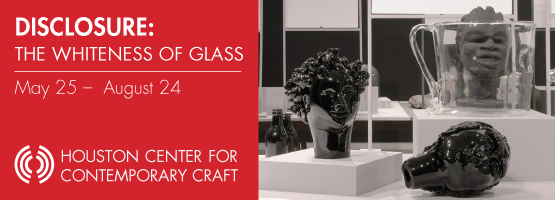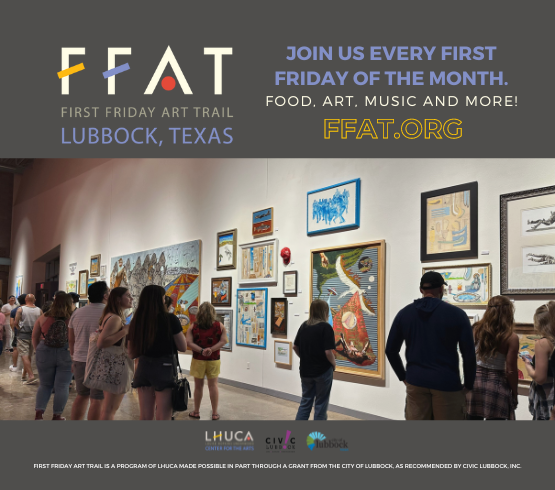Houston’s favorite provocateur Toni Leago Valle is back at it this fall with the premiere of 6 Degrees in her latest opus, POP DEMO, which she describes as “a dance/theater experience blending political commentary, offbeat theater, aerial, contemporary dance and visual projections.” POP DEMO runs Sept. 15-23 at the MATCH.
Arts and Culture Texas editor in chief Nancy Wozny visited with the choreographer to dive inside the world of POP DEMO.
Toni Leago Valle: The sneak peek was an introduction to a few of the characters: Mr. Pops, Lady J., and Monsieur Ballista; and the concept of using political cartoons and propaganda videos as the visual elements that run throughout the show. All of the characters are political cartoons, decked out in Pop Art colors, artwork, costumes, and makeup. Just a taste of what is coming.
ACTX: Sounds like you created a new place for dance!
TV: POP DEMO is a world all its own. Since the sneak peek, I have added the setting of the 1920’s Speakeasy and seven new characters, each representing two images – the 20’s Speakeasy character within the cartoon world, and an adjacent symbol of political propaganda in real life.
ACTX: Introduce us to the gang.
TV: Sure! Mr. Pops owns the POP DEMO Club but he is also the symbol for news and social media propaganda. Monsieur Ballista is the club bouncer and the NRA. New characters include Madame Bribe’ as the House Madame/Corporate Interests, Ms. Lovely as the Poker Dealer/Supreme Court, Billie as the Lounge Singer/ U.S. Legislation, Kid Charlie as the MC/Movie and Entertainment Industry, and the two waitresses, Mad Marge/Marjorie Taylor Green and Q-Anon, and Jane Roe/Roe vs. Wade. The only character that signifies one image is Lady J as the club crasher who ushers in the ideals of truth and integrity, shattering the club’s illusion.
TV: My aesthetic has always been a combination of humorous, theatrical, storytelling, and gestural due to my extensive theater background. (I originally set out to be an actress and then found the dance programs at University of Houston.) Now I have added aerial dance, simply because I love doing it and love the new dimension to my art. However, integrity and humor are the driving forces of my work. My motto for my art and my own life is an anonymous proverb, “Life may not be the party we hoped for, but while we are here, we might as well dance.” It is the only way I can survive living on this planet.
ACTX: What drew you to the idea of a 20’s speakeasy?
TV: Two opposing ideas came together – the first was the comparison to the current sociopolitical climate. During the 1920’s alcohol was illegal – a testament of minority rule imposing their will on the masses. The very existence of a speakeasy was a revolt against the government of that time. It feels naughty and secret, but also fun and decadent.
ACTX: At some point cartoons enter the stage space.
TV: Yes. The second idea is the cartoon world laid on top of the speakeasy. Visuals of political cartoons move across two walls – another choreographed form of movement. Aerial apparatus hangs from the ceiling, wine barrels as tables and wooden chairs, and a poker table litter the set. The dancers take over the space on the floor and in the air to the live music of George Heathco and the Anti-Defamation Orchestra. Yes, a live band! It somehow all fits into the space with 40 audience members. It’s all insane and incredibly entertaining, which is the heart of 1920 entertainment.
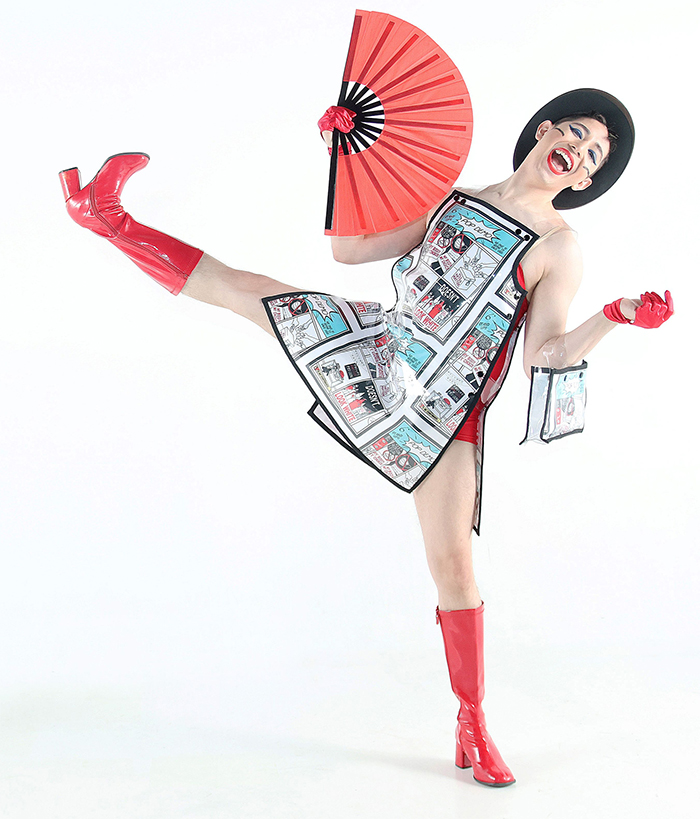
1 ⁄7
Carlos Perez as Mr. Pops in the 6 Degrees production of POP DEMO by Toni Leago Valle. Photo by Pin Lim.
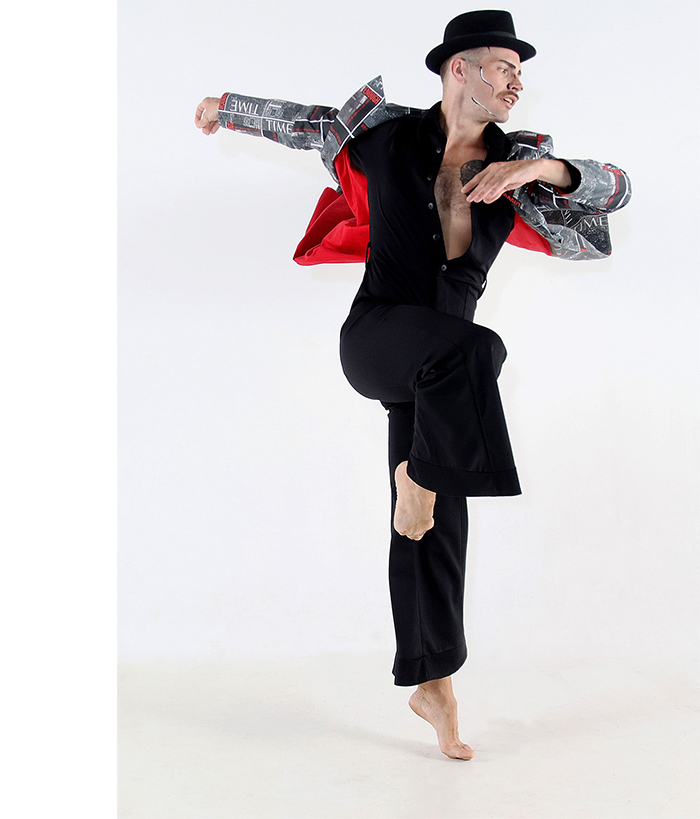
2 ⁄7
Travis Prokop as Monsieur Ballista in the 6 Degrees production of POP DEMO by Toni Leago Valle. Photo by Pin Lim.
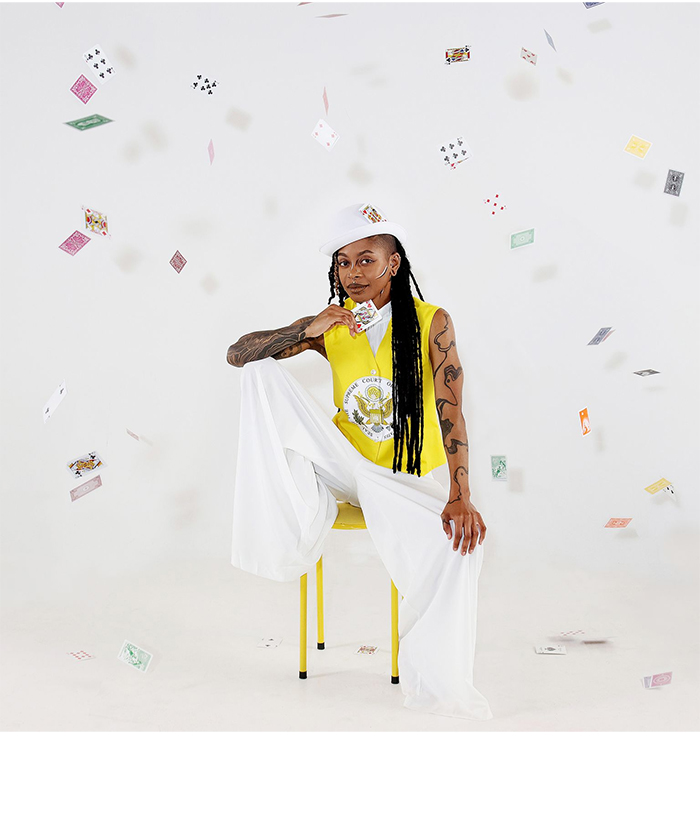
3 ⁄7
Tempest McLendon as Ms. Lovely in the 6 Degrees production of POP DEMO by Toni Leago Valle. Photo by Pin Lim.
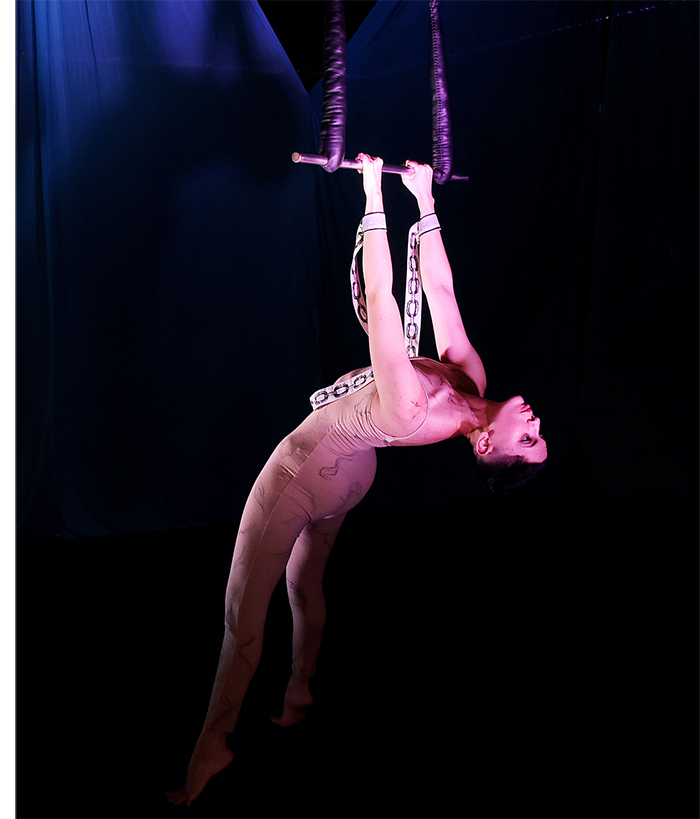
4 ⁄7
Michelle Reyes as Lady J. in the 6 Degrees production of POP DEMO by Toni Leago Valle. Photo by Pin Lim.
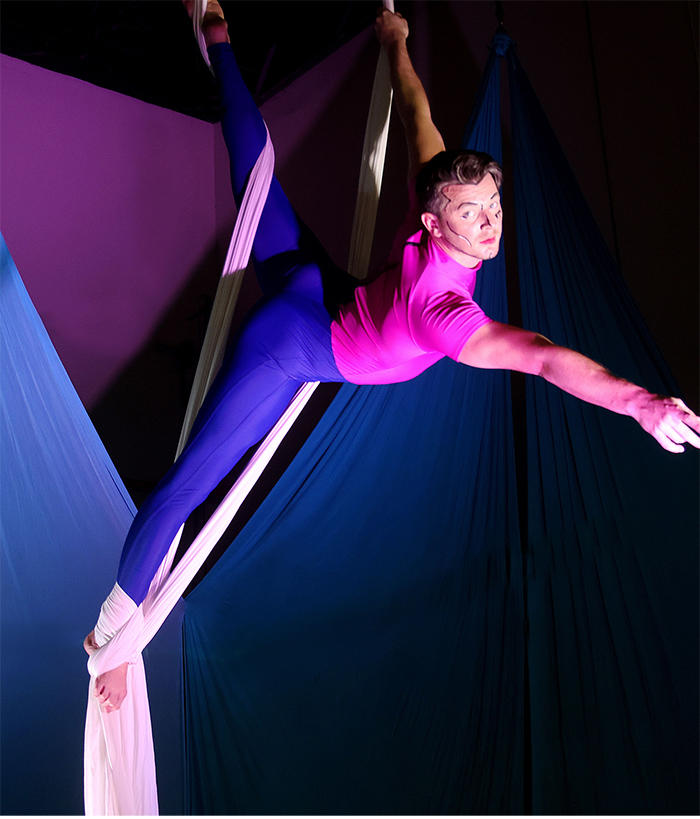
5 ⁄7
Davis Stumberg as Billie in the 6 Degrees production of POP DEMO by Toni Leago Valle. Photo by Pin Lim.

6 ⁄7
Mia Pham as Madame Bribe' in the 6 Degrees production of POP DEMO by Toni Leago Valle. Photo by Pin Lim.
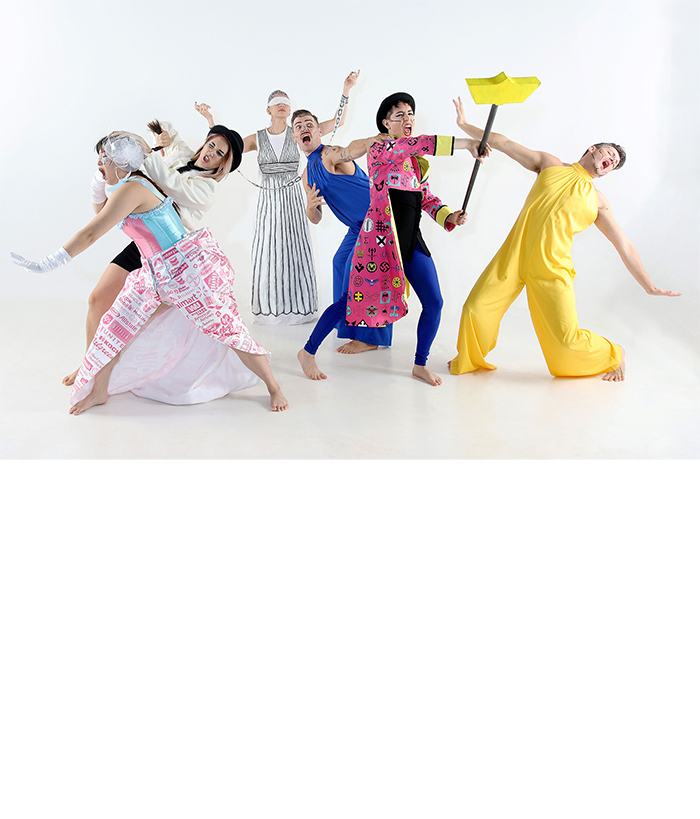
7 ⁄7
6 Degrees in the 6 Degrees production of POP DEMO by Toni Leago Valle. Photo by Pin Lim.
TV: Yes. I am a political activist and my artwork reflects my world. I have been working on POP DEMO for two years with two of my dancers, Carlos Perez and Michelle Reyes. This was after the January 6th Insurrection and during COVID; we were practicing aerial in my backyard with masks on, literally social distancing because we did not have vaccines yet. In the news, the U.S. was on fire in a way we had never experienced. It felt like nothing would ever be “normal” again. Everyone was making dances about being isolated. We questioned what could be said that has not been said already? How can we say it in a way that people want to hear it?
The world is an angry, confusing place right now; I think audiences want art to be socially relevant but also entertaining – a form of escapism. I know I do. That being said, I have to give credit where it is due – it was Carlos who said, “What about cartoons?” The lightbulb went on and we have been running with it ever since.
ACTX: What were the challenges?
TV: The characters are larger than life, as you would expect cartoons to be. The challenge is keeping them real in a human way so that we, the audience, care about them and want to be in their world. The intent of propaganda is to deceive the public and without lies it has no teeth. Propaganda has a built in fear of being unmasked. Mr. Pops does a lot of “mugging” towards the audience, but there is also a subtle sense of fear under his bravado, his true face. If Corporate Interests was a person, Madame Bribe’ is that personification. She is sensual and always selling herself – after all she’s the House Madame – but often is seen surveying with a smirk who is the next easy mark for her wares.
ACTX: You have some amazing collaborators on this project. Can you talk about the creative team?
TV: POP DEMO could not be created without the imagination of costume designer Judy Masliyah, composer George Heathco, and light designer Hudson Davis. I have a working history with all of them and they get me and my weird ideas. I designed the costume graphics and artist Scott Woodard drew some original artwork. Judy designed the costumes and worked within the cartoon and 1920 aesthetic. The results are comic strips with top hats, a TIME magazine duster coat with a fedora, a bustle skirt with corporate logos, and more. George is moving between a few songs that were already composed that he is transcribing, but most of the music is original compositions of a mix of 1920’s and contemporary jazz. George is bringing a live band that includes a clarinet to give it that authentic 20’s vibe. Hudson Davis has a distinct talent for lighting from the ground and air, which is necessary for aerial work. This is a dream team.
TV: Because of my theater background, I believe that any prop must be necessary, and used well within context. My first task is always to ask – what setting supports this work? “Never Again” was a 1930’s vaudeville circus, alluding to the circus of Texas Politics. POP DEMO’s two colliding worlds also lend itself to aerial work both as a prop and as a movement aesthetic.
In the 20’s, the Great Depression was on the horizon. There was a sense of both escapism and loss of American idealism after World War I. Entertainment was in the form of silent movies, dancing, and small live acts on stage. In the cartoon world, reality does not exist. Cartoons defy gravity in the form of frozen pictures. Literally anything can happen.
Aerial is not only fun in both environments, it is absolutely necessary to make the space three dimensional and unstable. Silks allow me to reconfigure backdrops and change the shape of walls, double as curtains, flowing drapes, and backdrops for projections. Trapeze and silks allow people to be suspended in the air.
ACTX: Humor is a bit part of your work but when I think about the current state of the world, nothing much is funny. How do you deal with that dilemma?
TV: Two ideals: I believe in the goodness of humanity and I play the long game. Propaganda is designed to make us think the world and humans are terrible by nature; they must be divided and controlled through despair, fear, and defeat. Whether it is in-your-face lies or more subtle broadcasting of negative news for ratings, propaganda distorts our worldview. Unfortunately, online is how most of us see the world beyond our windows. What we do not see on the news are the millions of communities helping one another, individuals taking care of one another.
I also believe in the long game – that justice does prevail. History has shown that evil ideas and people are eventually defeated because the masses will only tolerate suppression for so long. History is on our side.
On a more personal note, I have to dance, to laugh, to find humor in the dark. I have to uncover the joy and share it with others; it is embedded in my bones. This has always been my weapon against adversity – without it, I would not make art.
An example is a cameo appearance of Ted Cruz running through the club with his suitcase. Cruz is such good fodder for a joke.
TV: I am fortunate to have an amazing cast of diverse performers across talent, age, and experience. Half the cast identifies LGBTQ, four men, five women, ages 20-30’s. The cast includes Lizzy Aguilera, Haley Lee, Tempest McLendon, Carlos Perez, Mia Pham, Travis Prokop, Davis Stumberg, Nick T’Vegan, and Michelle Reyes. All have strong opinions of the world they live in, the work we are creating, and the characters they are embodying. It would be negligent not to use that wealth of information.
Some of the characters were created around the dancers’ personalities. Carlos Perez literally re-imagines himself with each costume change. Bigger than life, never the same person twice, a bad guy who at heart is a song and dance man, this role was built for Carlos. On the other extreme is Michelle Reyes, who is subtle, understated, graceful, and strong. She is the counterpoint to all the chaos. Michelle in a nutshell. I literally created a work around Haley Lee, who is the insane personification of Marjorie Taylor Green.
This cast is also versatile. We have non-gender or gender bending costuming happening on stage because cartoons are not bound by gender (No one cared that Bugs Bunny sang opera in drag). I give the dancers the mold, but each dancer is defining the character themselves. Davis Stumberg is the Lounge Singer, so he wears a dress. However, how Davis interprets the character is not defined by the dress. Travis Prokop plays the NRA, but he brings a distinctly emotional human sensitivity to the role that is all Travis.
It is also the first time I have five dancers who are trained aerialists. In the past, I had to give novice aerialists basic sequences. This company is co-creating the aerial works as those works are based on their specific abilities. Now, anything is possible.
TV: There are seven wooden seats on stage around the barrels and poker table as part of the set. Audience viewers can choose a traditional seat along the wall, or they can choose to be part of the performance by sitting on stage. They might get sat on, asked to stand, hold something, or play a game of poker. Fedoras and other accessories will be on the barrels for added fun.
If I had a big enough space, I would have had just tables and chairs for a true nightclub experience, but when I mapped it out, it only left room for 20 people in the audience and no room for the dancers. So I compromised with a few chairs on stage and three rows of chairs against one wall. I love the effect of audience members watching other audience members react to the show. It feels more communal to not have a separate viewing experience.
That being said – audience members do get a seat. I am too old to not have a seat.
-NANCY WOZNY



